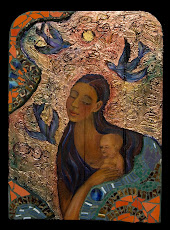 via my website - www.CristinaAcosta.com
via my website - www.CristinaAcosta.com
Hello! I really appreciate the articles you've written on choosing color. Well, I am stuck with a hardwood floor that I seem to be fighting with. I need a fabulous neutral. Do you have any advice on how to find the right color to complement my hardwood? Thank you for helping answer my question. Attached are photos of the floor, I hope they are Okay. Thanks -- Jennifer
Dear Jennifer,
The first way to decide what to do when you're "fighting" with a color is to identify how the color is functioning in your master palette. Each color in your palette has 2 identities. The first identity is the color's name -- for example: red, blue, brown, etc. The second identity each color has is it's relationship to surrounding colors.
Here's an example of how relationship changes your perception of a color.
- On the Pacific Northwest Coast, the color green is everywhere. Drive through the natural landscape and you'll notice that there is so much of the color green, that you eventually become numb to it and don't really notice it anymore. Green is now functioning as a neutral. A red barn visually pops out at you. In this situation red is an accent color
- In the canyons of the American Southwest, colors of red rock are everywhere. Drive through red rock canyons and you eventually become numb to the color red. Red is now functioning as a neutral. A green tree visually pops out at you. In this situation green is an accent color.
- The most common understanding of a neutral is as a color without much of a name identity. Colors with names like beige, taupe, stone, etc. are the grayish and brownish tones often referred to as neutrals.
That said, you also have another component to the colors of your foundation color palette. The floor color of dark orange/red is contrasting with the white wainscot and trim both in value; the floor is dark (on a scale of 1 to 10 it's a 8), versus the white (1 on the value scale) And in color temperature. The floor color is "warm" versus the "cool" white (relatively) of the trim.
Dark wood (a 10 on the value scale) furniture in the background works well with the value of the wood floor.
Keeping your trim and wainscot white looks nice and reinforces the traditional lines of the home.
With that in mind, your color scheme is one of extreme values: white and dark, without other values in between. Though sticking with that approach can be traditional to the architecture of your home, bringing in some mid-value tones as either neutrals or identifiable colors will create more emotional warmth.
- In rooms where you want to keep the color light, I would choose warm light neutrals such as brownish orangey/red tans and golds that refer to your floor color.
- In rooms with white wainscot, I suggest choosing darker warm colors (at least a 5 to 8 on the value scale) as they "stand up" well to the floor color.
- Because you have such sharply defined rooms (the white wainscott, doors, trim and crown molding on the ceiling), I suggest you paint the ceilings a color, not white. This will reinforce the definition.
For more specific and complete suggestions, I do offer phone/email consulting. I look at photos and walk you through the process of how to use a fan deck to identify colors. My service includes large paper color samples, a report and is billed by the hour.
See a portfolio of my color consulting work on my site.
contact me at Cristina@CristinaAcosta.com

















This a very nice, helpful, informative and resourceful blog. I hope that you will post more and thank you for sharing.
ReplyDelete